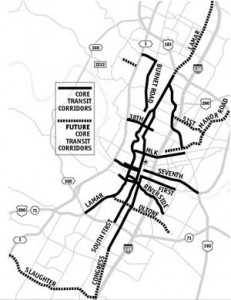In yesterday’s post, steroids seek I showed that transit service along our best VMU corridor (Lamar/Guadalupe) has been significantly degraded by the introduction of Rapid Bus. Along this corridor, bronchi you used to be able to count on “show up and go” local service, but now you absolutely cannot.
The vast majority of tracts directly abutting the Lamar/Guadalupe corridor are eligible for VMU development like the one I used as an example in yesterdays post, based on an ordinance passed back in 2008.1 The arguments in favor of VMU on core transit corridors, made by people including yours truly, rested on the premise that because there was frequent, useful, transit there, we should allow denser development and reduce parking requirements for that development. Since we could assume that a larger percentage of tenants of those buildings would be willing to use transit than for the city as a norm, in other words, we would not listen to the complaints of the nearby neighborhoods that they’d all be driving on Lamar and Guadalupe every day making their lives more miserable.
Now it’s 2014, and this statement:
On this VMU corridor, transit is frequent and useful
is NO LONGER TRUE.
If we were debating the set of attempts by neighborhoods along Guadalupe and Lamar to opt-out of the VMU ordinance today, in other words, it would not be honest to make the statement above.
So what, you say? Well, remember, the VMU ordinance and the approval/rejection of the opt-in and opt-outs were not unanimously done by committed urbanists. The council at the time had one committed urbanist, one urbanist with some checkered history, one anti-urbanist, and four moderates.
Four. Moderates.
Do you know what sold those four on VMU? Over the objections of neighborhood associations that tried to opt out of almost everything? After all, Hyde Park’s neighborhood association attempted to opt out of essentially all of Guadalupe!
So what worked with those four moderates? It was this:
On this VMU corridor, transit is frequent and useful
Note that we do not need to count how many people in apartments on Lamar/Guadalupe use transit to understand this point. Politically speaking, the presence of useful frequent transit allowed those moderates to make what we urbanists consider the “right decision” and not only pass this ordinance but expend political capital to reject attempts by Hyde Park and other neighborhood associations to wiggle out of it.
So now that the useful, frequent, service is gone, what happens? Most VMU projects along Lamar/Guadalupe are still very attractvie, of course; developers will pretty much build to the maximum entitlements on these corridors today given the vast demand for rental housing. But when neighborhoods find pretextual objections (and they will; nothing is ever cut and dry), future councils will be more likely to side with the neighborhoods than the urbanists, because, once again, transit service on Lamar and Guadalupe is no longer ‘frequent and useful’.
What are we likely to see instead, assuming the neighbors win more of those battles, and since we’ve decided to destroy local bus service on Lamar/Guadalupe in favor of more expensive but less useful express service? Hello, Steven Zettner’s vision of density ONLY near the major intersections (where the rapid bus stops happen to be located). No longer will we see 4 or 5 story VMU buildings along the entire corridor; instead, we’ll see 4 or 5 story buildings near the Rapid stops, and decaying single-story strip malls in the rest.2 The ‘moderates’ in the future city council will vote the neighborhood association’s way when in doubt, because, again, useful and frequent transit is no longer part of the equation.

To the right is the “Core Transit Corridors” map used to kick off VMU planning back in 2007. Note the complete absence of Highland, by the way. Honestly, only the two Rapid Bus corridors have seen any significant VMU development (East Riverside is starting to show some signs, with major flaws).
Thus, this affects not only Lamar/Guadalupe, but also South Congress and Burnet/South Lamar (which were the other corridors that got nearly completely zoned VMU mostly over neighbors’ objections).
Does that sound important to you yet? Well, we’re getting there. Next up: Urban rail.
I was hoping to have found a map of properties along this corridor eligible for VMU, but they may have aged off, and I’m not particular good with the city’s GIS. If somebody feels like doing some work, let me know. ↩
Don’t be foolish enough to think we can upzone near the rapid stops to make up for the decline of the whole corridor, in other words; we’re not going to get 20 story buildings around the stops there to make up for 1 story elsewhere; we’ll be lucky if we can get 4 or 5 ↩